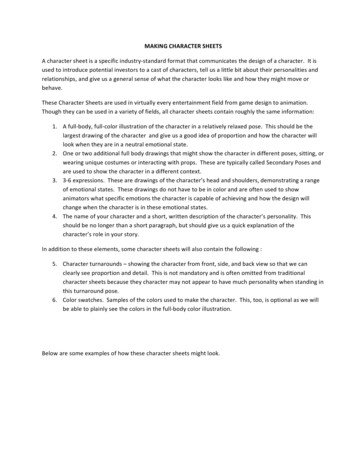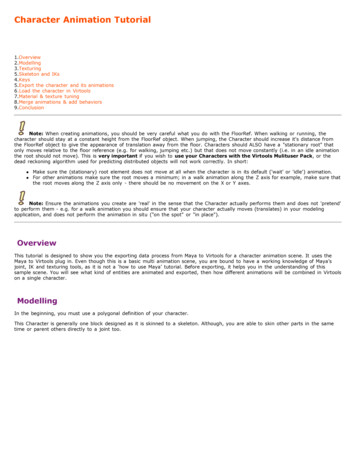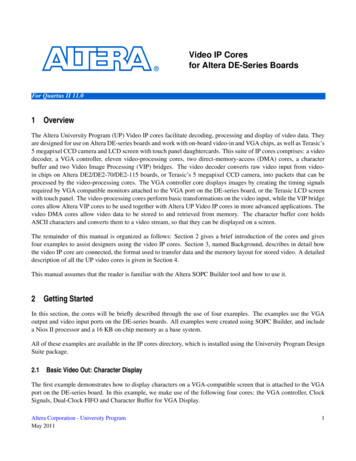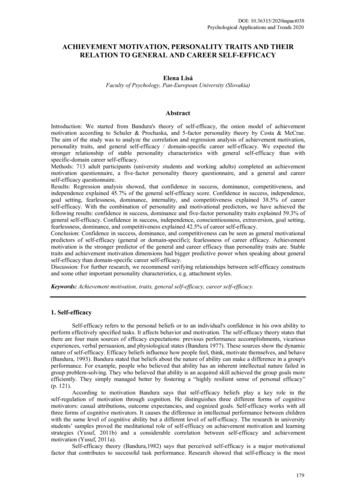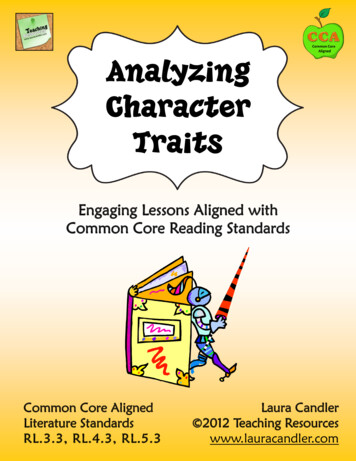
Transcription
AnalyzingCharacterTraitsEngaging Lessons Aligned withCommon Core Reading StandardsCommon Core AlignedLiterature StandardsRL.3.3, RL.4.3, RL.5.3Laura Candler 2012 Teaching Resourceswww.lauracandler.com
AnalyzingCharacter TraitsCreated by Laura Candlerwww.lauracandler.comTeacher Information and DirectionsThis mini pack includes a variety of strategies and printables for teaching students how toanalyze character traits. You’ll find a lesson on how authors reveal character traits, twocharacter trait lists, a variety of graphic organizers, several cooperative learning activities,and a list of suggested character trait books. In addition, all of the character maps areavailable in landscape format in a separate PDF file for use with an interactive whiteboard.These lessons are designed to take place intermittently over a period of several weeks orthroughout an entire school year.Why Teach Character Traits?Character analysis offers an easy way to add rigor to any literature discussion. Charactertrait studies actively engage students and help them develop an understanding ofcharacters’ motives. Studying character traits teaches students how to make appropriateinferences from facts. Furthermore, students deepen their understanding of literature bylearning to support their opinions with details from the selection. Students enjoy debatingand discussing character traits as their vocabularies develop. As a teacher, you’ll enjoy thefact that these printables can be used repeatedly throughout the year simply by focusingon different characters and traits.Common Core State Standards for LiteratureThe lessons in Analyzing Character Traits are perfect for helping youteach Common Core Literature Standards in Grades 3 through 5. Thecharacter development component of each standard below can betaught using some or all of the materials in this packet. However, inorder to teach all aspects of each standard, you’ll need to findadditional resources for the other topics described by that standardsuch as story settings and events.Grade 3 - 5 Standards That Reference Character Development Grade 3 RL 3.3 Describe characters in a story (e.g., their traits, motivations, orfeelings) and explain how their actions contribute to the sequence of events. Grade 4 RL 4.3 Describe in depth a character, setting, or event in a story or drama,drawing on specific details in the text (e.g., a character’s thoughts, words, or actions). Grade 5 RL 5.3 Compare and contrast two or more characters, settings, or events in astory or drama, drawing on specific details in the text (e.g., how characters interact). 2012 Created by Laura Candler Teaching Resources www.lauracandler.com2
Step-by-Step Lessons for Analyzing Character Traits1. Advanced Preparation - Locate several short read-aloud books withmemorable characters. You’ll find a bibliography of suggested bookson page 22. In addition, you can use short selections from a basalreading text. Biographies work well for character trait lessons, butfictional characters can also provide a rich source of discussion.Duplicate a Character Trait list for each student. You’ll find twoversions on pages 6 and 7. You may want to duplicate the list oncolored paper and laminate it since your students will be referring tothis list frequently throughout the year. It’s also helpful to locateindividual dry erase boards and markers for each student. Many ofthe lessons involve active participation, and dry erase boards are aneasy way to involve all students.2. Introduction to Character Traits - Begin by explaining the term“character trait.” A simple definition might be the personal qualitiesthat a character demonstrates such as bravery or loyalty. Ask studentsto think of a character from a recent book and name one charactertrait that describes the person. Randomly call on students or havethem write their responses on individual dry erase boards to showyou. In general, physical qualities like height or hair color are notconsidered to be character traits.3. Emotions versus Character Traits - Some students may be confusedabout the difference between emotions and character traits. Explainthat the two terms are similar, but emotions can change frommoment to moment, while character traits are developed over time.For example, a character may generally exhibit the trait ofcheerfulness, yet he or she may feel the emotion of sadness when afriend moves away.4. Distribute Character Trait List - Distribute one copy of thecharacter trait list to each student. Emphasize that they need to storethis list in a safe place and take care of it because they will be using itrepeatedly throughout the year. Ask them to read over the words,but don’t stop to explain the meaning of each one. Later you’ll befocusing on a new word each day as you discuss characters in storiesand biographies.5. Character Clues Overview - Now ask students how they thinkauthors reveal a character’s personality to readers. Point out thatauthors seldom use character trait words to describe characters;instead, they include clues throughout the selection. Display theCharacter Clues overview on page 6 and discuss each type of cluewith your students. As you discuss the difference between actionclues, verbal clues, and other clues, ask them to cite examples frombooks or stories you have recently read. 2012 Created by Laura Candler Teaching Resources www.lauracandler.com3
6. Character Trait Analysis - Immediately after introducing theCharacter Clues overview page, display the Character Cluesgraphic organizer on page 9 on a overhead projector orwhiteboard. Read aloud a short book such as Tacky the Penguinand ask students to brainstorm a list of character trait words thatdescribe the main character. If their Character Trait list islaminated, they can circle the words on that list. If not, they canwrite them on a dry erase board or add to a class list on aninteractive whiteboard. Then choose one character trait andwrite it in the center of the graphic organizer. Read through the book another time, askingstudents to notice actions, words, and other clues that support this trait. Add their ideas tothe class graphic organizer. Don’t worry if you can’t find a detail for every category. In thiscase, you might want to use the graphic organizer several times with different characters toreinforce the concept of character clues.7. Daily Character Trait - This lesson is designed to take placeduring 15-minute daily mini-lessons over a period of severalweeks. During that time, your students will develop a characterreference chart. Distribute copies of the Character TraitReference on page 10. and display a copy for the class. Each dayread a short selection or refer to a character in a chapter book.Identify a character trait that applies to the main character,making sure it’s one that your students might not already know,such as gullible or ambitious. Write the word in the first columnand explain the meaning of the word. Have students help you write a definition for thesecond column. Then have students brainstorm clues from the selection that support thischaracter trait and record them in the Literary Examples column. Add one word a day tothe chart until you’ve introduced all of the challenging words on the character trait list.8. Character Trait Sorting - To check for understanding, placestudents in teams of three or four and give each team one copyof the Character Trait Sorting map on page 11 and a set ofcharacter trait word cards. Use the cards on page 12 or createyour own with the template on page 13. Students cut the cardsapart and stack them face down in the middle of the chart. Oneby one, they take turns flipping over a card, reading it aloud,and discussing it with the team. The team decides if the trait isgenerally thought of as a positive attribute or a negative attributeand the card is placed face up in the appropriate spot. If it’sneither positive or negative, they place it in the “Neutral” box. Ifthey don’t know the meaning, they place it in the “Unknown”section. Students take turns flipping over and placing the cards sothat everyone participates equally. Finally, discuss the teamanswers as a class. An alternate strategy would be to stop andhave a team discussion after every word is placed on the sortingmap. This will keep each discussion short and focused, preventingstudents from becoming bored during one long class discussion. 2012 Created by Laura Candler Teaching Resources www.lauracandler.com4
9. Basic Character Map - After students are comfortable withmost of the words on their Character Trait list, it’s time to revisitthe concept that a single character often displays numerouscharacter traits. The Character Map graphic organizer on page 15is an excellent tool for working with this idea. Completedirections for introducing the Character Map to your studentscan be found on page 14. You can also find a completedexample based on the book Goldie Socks and the ThreeLibearians on page 16.10. Character Comparisons - Comparing characters is another wayto deepen understanding about character traits and motives. Usethe Comparing Characters Venn diagram on page 17 to comparetwo characters from the same story or characters from differentstories. Students can even compare characters with themselves.Allow students to use physical attributes as well as charactertraits to describe each character.11. Character Development - In some stories and biographies, themain character undergoes a significant transformation as a resultof an event or interaction with another character. The CharacterDevelopment map on page 18 offers a way to analyze acharacter before and after the change takes place. You may wantto use the instructional sequence on page 14 to introduce thisgraphic organizer. It’s always best to introduce a new graphicorganizer to the entire class or a guided reading group beforeassigning it to individuals to complete alone.12. Character Trait Challenge - As a culminatingactivity, involve your students in the Character TraitChallenge. Students work in teams of three or four tocreate a team poster displaying the character traits ofa significant character from a biography or otherliterary selection. Complete directions and printablescan be found starting on page 19.GillyHopkinsIf you enjoyed my Analyzing Character Traits pack, pleasecheck out my other resources in these locations. Thanks! TeachersPayTeachers a-Candler Teaching Resources Websitehttp://www.lauracandler.com Corkboard Connections Bloghttp://www.corkboardconnections.com. 2012 Created by Laura Candler Teaching Resources www.lauracandler.com5
Character witty 2012 Created by Laura Candler Teaching Resources www.lauracandler.com6
Character eselfishshyslysneakyspoiledstubbornthoughtful 2012 Created by Laura Candler Teaching Resources www.lauracandler.com7
Character CluesAuthors reveal character traitsby providing clues in the text.Action Clues - Character traits are revealedthrough the actions and reactions of the character.Good readers carefully observe how the characterbehaves to make inferences about character traits.Example: Standing up to a bully shows courage.Verbal Clues - Character traits are revealed by whatthe character says and how those words aredelivered. Sometimes clues can be found in whatcharacters say about each other. Example: Acharacter who yells, “No! We’re going to do it myway!” might be considered bossy.Other Clues - Character traits can be revealed byother clues such as physical appearance, how thecharacter dresses, where he or she lives, interestsand hobbies, and so on. Example: A tiny girl whowears frilly dresses might be considered dainty. 2012 Created by Laura Candler Teaching Resources www.lauracandler.com8
2012 Created by Laura Candler Teaching Resources www.lauracandler.com9Other CluesVerbal CluesCharacter NameSelection TitleCharacter TraitAction CluesDefinitionCharacter Clues
2012 Created by Laura Candler Teaching Resources erary ExampleDefinitionCharacter Trait Reference
2012 Created by Laura Candler Teaching Resources www.lauracandler.com11? Unknown Neutral Traits Negative Traits Positive Traits Character Trait Sorting
2012 Created by Laura Candler Teaching Resources antbashfulstudiousconsiderateCharacter Trait Sorting Cards
Character Trait Sorting Cards 2012 Created by Laura Candler Teaching Resources www.lauracandler.com13
Introducing Character MapsOverviewTo make sure students understand how to use thisgraphic organizer, introduce it in stages. Each step isdescribed below, and the steps move from teacherdirected instruction to independent practice. Theentire sequence may take a week or more.Instructional Sequence1. Whole Group Lesson - After reading a selection from a chapter book, have studentsbrainstorm a list of traits that describe the main character. Call on students randomly to sharetheir ideas, making sure they justify their suggestions with clues from the book. Distributecopies of the graphic organizer, and have students write the main character’s name in theoctagon. Then choose one character trait and have the entire class write that trait in the topoval. (Refer to the example on page 16.) Display a blank copy of the graphic organizer sothey can see how the process works. Write supporting details in the top rectangle and includepage number references if possible. Depending on the time allotted for this lesson, you canfocus on one trait a day or complete the entire graphic organizer all at once.2. Guided Reading Groups - This graphic organizer works well in a guided reading group.You can read the selection to the entire class, but complete the graphic organizer togetherwithin the small group setting. Before adding each character trait to the map, discuss itthoroughly in the group and have students look back in the selection for supporting details.3. Partner Practice - The last step before completing the Character Map independently is tocomplete it with a partner. Each person begins by jotting down 4 or 5 character traits thatapply to the main character. Then they take turns completing the parts of the graphicorganizer. One person states a trait and explains the supporting details. If his or her partneragrees, that information is added to the map. If there is disagreement, they select a differentcharacter trait or ask for help. Then the other person names a trait, justifies his or her choice,and records it on the Character Map. By the end of the activity, each person will havecompleted 2 ovals and 2 rectangles. The benefit of working with a partner is that studentsgain a deeper understanding of character traits by discussing and justifying them.4. Independent Practice or Assessment - Finally, students should be able to complete thegraphic organizer without help. Using the Character Map this way works well as a literacycenter activity, preparation for a literature circle discussion, or as an assessment.Note: This sequence of instruction can be used to teach any of the character graphicorganizers in this mini pack. It would be especially effective with the Character Developmentgraphic organizer on page 16. 2012 Created by Laura Candler Teaching Resources www.lauracandler.com14
2012 Created by Laura Candler Teaching Resources www.lauracandler.com15Selection TitleDateNameCharaM ctap er
2012 Created by Laura Candler Teaching Resources www.lauracandler.com16April 15, 2010DateGoldie Socks and theThree LibeariansSelection TitleJonathan BatesNameGoldieSocksCharaM ctap erpersistentintelligentcuriousbravePages x - xuntilshe found something just right.differentbooks and places to read. She didn’t give upGoldieSocks was persistent because she kept looking forPages x - xforher.usethe 5-finger rule to figure out which book was rightGoldieSocks was intelligent because she knew how toPages x - xcuriousabout what was in the books.whatwas in the house in the woods. She was alsoGoldieSocks was curious because she wanted to knowPages x - xbecause she entered the cottage and explored it.through the woods on her own. She was also braveGoldie Socks was brave because she went walking
DateNameCharacter Comparison 2012 Created by Laura Candler Teaching Resources www.lauracandler.com17
2012 Created by Laura Candler Teaching Resources www.lauracandler.com18Character Trait CluesCharacter Trait(s)What caused thischaracter to changeduring the story?CauseCharacterCharacter Trait CluesCharacter Trait(s)
Character Trait ChallengeMaterials for each team of four: Large sheet of construction paper orposter paperScissors and glue sticksOne rhombus pattern (half of page 18)Character Trait slips (2 or 3 copies of page 19)Character Trait listOne or more copies of the same book or story(basal reader biographies work well)GillyHopkinsDirections:1. As a class, select an important character from a read-aloud book, novel, or basal readerstory that everyone has read recently.2. Challenge your class to see which team can name and justify the most character traits forthat character in a given period of time.3. Give each team one copy of the Character Trait slips page and have them cut it apart sothat everyone starts with two slips of paper.4. Ask them to think of character traits that describe the character and that can besupported with details from the story. Each person should write one character trait onhis or her slip of paper and look for a page in the story that contains a supportingdetail. The detail and page number should be recorded on the slip of paper. Studentsalso need to record their first name on the line.5. Team members should discuss the character traits and details as they work to be surethat they don’t duplicate traits. If they run out of slips, provide them with additionalcopies. Encourage your students to help each other with finding character traits andsupporting details from the selection.6. Have students place the rhombus in the middle of the poster paper and write the nameof the character inside. As they complete each character trait slip, they should place itsomewhere on the poster around the heart and glue it down.7. Allow at least 30 minutes for this activity. When time runs out, allow students to walkaround the room and view each other’s posters. Decide which team has the mostcharacter traits that are supported by details from the story. Students may challengeeach other’s character traits and details if they don’t agree with them. You can alsoaward bonus points for teams that come up with character traits that are unique to theirteam poster (no other team thought of that trait).8. If you grade this activity, assign individual grades by counting the number of traitsfound by each student and the quality of the responses. 2012 Created by Laura Candler Teaching Resources www.lauracandler.com19
2012 Created by Laura Candler Teaching Resources www.lauracandler.com20
TraitTraitSupporting Details:Supporting Details:Page(s) NamePage(s) NameTraitTraitSupporting Details:Supporting Details:Page(s) NamePage(s) NameTraitTraitSupporting Details:Supporting Details:Page(s) NamePage(s) NameTraitTraitSupporting Details:Supporting Details:Page(s) NamePage(s) Name 2012 Created by Laura Candler Teaching Resources www.lauracandler.com21
Picture Books for Character Trait LessonsBiedrzycki, David. Ace Lacewing, Bug Detective.Watertown, MA: Charlesbridge, 2005.Cannon, Janell. Stellaluna. New York: Scholastic, 1993.Coles, Robert, and George Ford. The Story of Ruby Bridges. New York: Scholastic, 2004.Gilman, Phoebe. Jillian Jiggs. New York: Scholastic, 1988.Hopkins, Jackie M. Goldie Socks and the Three Libearians. Fort Atkinson:UpstartBooks, 2007.Jackson, Ellen B., and Kevin O'Malley. Cinder Edna. New York: Mulberry, 1998.Kellogg, Steven. Jack and the Beanstalk. New York: Morrow Junior, 1991.Lester, Helen, & Lynn Munsinger. Hooway for Wodney Wat. New York: Scholastic, 2000.Lester, Helen, and Lynn Munsinger. Tacky the Penguin. Boston: Houghton Mifflin, 1988.Levine, Ellen, and Kadir Nelson. Henry's Freedom Box. New York: Scholastic, 2007.Madonna, and Loren Long. Mr. Peabody's Apples. New York: Callaway, 2003.Munsch, Robert N., and Michael Martchenko. The Paper Bag Princess. Lindfield,NSW: Scholastic, 2006.O'Neill, Alexis, and Laura Huliska-Beith. The Recess Queen. New York: Scholastic, 2002.Pfister, Marcus, and J. Alison James. The Rainbow Fish. New York, NY: NorthSouth, 2006.Polacco, Patricia. Thank You, Mr. Falker. New York: Scholastic, 1999.Steig, William. Shrek! New York: Farrar Straus Giroux, 2010.Seuss, and Charles D. Cohen. Yertle the Turtle. New York: Random House, 2008.Viorst, Judith, and Ray Cruz. Alexander and the Terrible, Horrible, No Good, VeryBad Day. Dubuque, Iowa: Kendall/Hunt, 2007.Watt, Melanie. Scaredy Squirrel. New York, N. Y.: Scholastic, 2009.Whitcomb, Mary E., and Tara Calahan. King. Odd Velvet. San Francisco: Chronicle, 1998. 2012 Created by Laura Candler Teaching Resources www.lauracandler.com22
If you enjoyed this free teaching resources pack, you might also enjoy some of my popularebooks and lessons. You can purchase them from my store on TeachersPayTeachers.com byclicking the links below or by visiting my Teaching Resources website: www.lauracandler.com.Teaching Multiple Intelligence TheoryBingo Showdown:Confusing Words ReviewCharacter Bio ReportsAnalyzing Character TraitsPowerful Poetry ComboPlural Noun ShowdownSentence Go RoundWriting Powerful PoetryGeometry: Exploring the BasicsMath Stations for Middle Grades (3-8)Mastering Math FactsSeasonalTeaching PacksPolygon ExplorationsOctoberPlace Value Spinner GamesNovemberDecemberJanuaryPolygon Explorations (Smartboard)Fraction Spinner GamesSimplify and Snap Fraction GameOrder of Operations BingoFebruary (Free!)MarchApril 2012 Created by Laura Candler Teaching Resources www.lauracandler.com23
Teaching Resources Websitewww.lauracandler.comReady-to-Use Resources for Teachers! Free printables and activity sheets Lesson plans and teaching strategies Cooperative learning methods Classroom management and motivation Literacy & Reading Workshop strategies Mathematics instructional resources Weekly NewslettersNEW!Are you on Facebook? If so, checkout Teaching Resources for new ideas:www.facebook.com/TeachingResourcesDiscover Laura’s Teaching Resources . . . Digital eBooks and lessons you can download fromwww.lauracandler.com and print or use ona Smartboard!Each book, ebook or lesson pack includes ready-to-usedirections, printables, and teaching tips!Popular titles include: Mastering Math FactsCreated by Daily Math Puzzler SeriesLaura Candler Math Stations for Middle GradesMilken Educator Laura Candler’s Power Reading Workshop Laura Candler’s Graphic Organizers for Reading
second column. Then have students brainstorm clues from the selection that support this character trait and record them in the Literary Examples column. Add one word a day to the chart until you've introduced all of the challenging words on the character trait list. 8. Character Trait Sorting - To check for understanding, place

